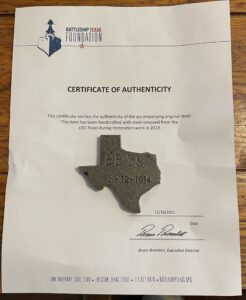…it is battleship steel.
And it isn’t just battleship steel, it is (I’m pretty sure) low background steel.
Sadly, though, low background steel ain’t what it used to be.
You know, I wonder if you could forge a knife out of Battleship Texas steel…probably, if you could get enough of it from the Foundation. That’d be a cool gift shop item.
On a semi-related note, I find this slightly weird. No shade on Drachinifel: I’ve watched a few of his shorter videos, but don’t have time for his longer stuff. I guess it just seems odd that they’re using him as a draw. Even more so at $100 a head (drinks and “light snacks” extra).

Why is low background steel not the same as it used to be? And is it really that great of a thing, the low background steel?
I made steel for a living, for over 35 years. And have to wonder if the steel that we made, especially from virgin material, was low background. Since all of the materials would have been mined from underground, it should have been shielded from radioactive fallout.
We actually had to check the radiation level of some virgin materials coming in from certain parts of the world. Mostly things like Tellurium, Hafnium, and other rare elements that we used in making super alloys for jet engines. We used a Geiger Counter to check the metal before letting it come into the plant. And we also kept some of them locked in a safe, like Rhenium, due to both the possibility of contamination but also the extreme cost.
I melted heats of 8,000 lbs. that were worth 10 million dollars, due to the amount of both Rhenium and the expertise to melt the heat in the correct way, under high vacuum conditions. This alloy in particular was used in the hot section of jet engines. It kept it’s strength very close to it’s melting point, and the hotter the engine could run, the more efficient it would be.
Pigpen:
You know much more about steel production than I do (and I’m an enthusiastic amateur) so please correct me if i have anything wrong.
As I understand it, low-background steel isn’t as much of a thing any longer because we stopped setting off atomic bombs in the atmosphere. Since we’re not doing that any longer, we’re not getting fallout, and since we’re not getting fallout, we’re not getting the same background radiation levels.
“World anthropogenic background radiation levels peaked at 0.11 mSv/yr above natural levels in 1963, the year that the Partial Nuclear Test Ban Treaty was enacted. Since then, anthropogenic background radiation has decreased to 0.005 mSv/yr above natural levels.”
I also have the understanding that we’ve gotten better at computationally compensating for the existing background levels in steel, so we can basically tell our measurement equipment “ignore that”. But I’m not 100% sure where I picked that up.
Again, you know more about this than I do, so please feel free to correct anything I’ve got wrong.
How much rhenium would you add to 8,000 pounds of steel? And do know of any good diagrams of the equipment used to do the melt under high vacuum conditions? I’m trying to imagine the infrastructure involved, not just in melting four tons of steel, but melting it in a vacuum, and I can’t wrap my mind around that.
I wish industrial tours were still a thing, but that’s a rant for another time.
Stole pigpen’s comment.